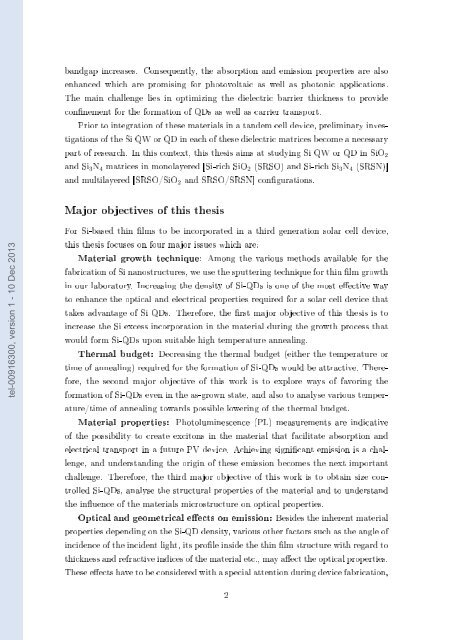Films minces à base de Si nanostructuré pour des cellules ...
Films minces à base de Si nanostructuré pour des cellules ...
Films minces à base de Si nanostructuré pour des cellules ...
Create successful ePaper yourself
Turn your PDF publications into a flip-book with our unique Google optimized e-Paper software.
andgap increases. Consequently, the absorption and emission properties are also<br />
enhanced which are promising for photovoltaic as well as photonic applications.<br />
The main challenge lies in optimizing the dielectric barrier thickness to provi<strong>de</strong><br />
connement for the formation of QDs as well as carrier transport.<br />
Prior to integration of these materials in a tan<strong>de</strong>m cell <strong>de</strong>vice, preliminary investigations<br />
of the <strong>Si</strong> QW or QD in each of these dielectric matrices become a necessary<br />
part of research. In this context, this thesis aims at studying <strong>Si</strong> QW or QD in <strong>Si</strong>O 2<br />
and <strong>Si</strong> 3 N 4 matrices in monolayered [<strong>Si</strong>-rich <strong>Si</strong>O 2 (SRSO) and <strong>Si</strong>-rich <strong>Si</strong> 3 N 4 (SRSN)]<br />
and multilayered [SRSO/<strong>Si</strong>O 2 and SRSO/SRSN] congurations.<br />
Major objectives of this thesis<br />
tel-00916300, version 1 - 10 Dec 2013<br />
For <strong>Si</strong>-<strong>base</strong>d thin lms to be incorporated in a third generation solar cell <strong>de</strong>vice,<br />
this thesis focuses on four major issues which are:<br />
Material growth technique: Among the various methods available for the<br />
fabrication of <strong>Si</strong> nanostructures, we use the sputtering technique for thin lm growth<br />
in our laboratory. Increasing the <strong>de</strong>nsity of <strong>Si</strong>-QDs is one of the most eective way<br />
to enhance the optical and electrical properties required for a solar cell <strong>de</strong>vice that<br />
takes advantage of <strong>Si</strong> QDs. Therefore, the rst major objective of this thesis is to<br />
increase the <strong>Si</strong> excess incorporation in the material during the growth process that<br />
would form <strong>Si</strong>-QDs upon suitable high temperature annealing.<br />
Thermal budget: Decreasing the thermal budget (either the temperature or<br />
time of annealing) required for the formation of <strong>Si</strong>-QDs would be attractive. Therefore,<br />
the second major objective of this work is to explore ways of favoring the<br />
formation of <strong>Si</strong>-QDs even in the as-grown state, and also to analyse various temperature/time<br />
of annealing towards possible lowering of the thermal budget.<br />
Material properties: Photoluminescence (PL) measurements are indicative<br />
of the possibility to create excitons in the material that facilitate absorption and<br />
electrical transport in a future PV <strong>de</strong>vice. Achieving signicant emission is a challenge,<br />
and un<strong>de</strong>rstanding the origin of these emission becomes the next important<br />
challenge. Therefore, the third major objective of this work is to obtain size controlled<br />
<strong>Si</strong>-QDs, analyse the structural properties of the material and to un<strong>de</strong>rstand<br />
the inuence of the materials microstructure on optical properties.<br />
Optical and geometrical eects on emission: Besi<strong>de</strong>s the inherent material<br />
properties <strong>de</strong>pending on the <strong>Si</strong>-QD <strong>de</strong>nsity, various other factors such as the angle of<br />
inci<strong>de</strong>nce of the inci<strong>de</strong>nt light, its prole insi<strong>de</strong> the thin lm structure with regard to<br />
thickness and refractive indices of the material etc., may aect the optical properties.<br />
These eects have to be consi<strong>de</strong>red with a special attention during <strong>de</strong>vice fabrication,<br />
2
















